|
Milking the nest egg for a lifetime
Mike and Sue Peters got derailed by the Nasdaq crash...here's how they can get back on track.
NEW YORK (MONEY Magazine) - In the heyday of the 1990s bull market, Mike and Sue Peters of Durham, N.C. got a jump-start on retirement. As Blue Cross and Blue Shield employees, they were eligible for pension and health-care benefits at age 55. That, on top of their 401(k) savings, allowed Mike to kick back. A year into Mike's retirement, however, the stock market nosedived and the couple's 401(k) portfolios -- stuffed with technology and other high-risk stock funds -- lost a third of their value. Mike returned to Blue Cross, where he works 30 hours a week as a business analyst. Still, he hopes to cut back by fall, and Sue wants to retire completely in 2007. Where are they now
Mike, 60, and Sue, 55, make a combined $150,000, and they dutifully contribute at double-digit rates to their 401(k)s. Most of their finances are the picture of prudence: They'll pay off their mortgage this year, they own a house in Myrtle Beach free and clear, and they have no other debts beyond a car loan. But when it comes to investing, the scalding they took in the tech crash hasn't stopped them from chasing after what looks hot: a full 45 percent of their $450,000 portfolio is in international stock mutual funds, and another 20 percent is in energy-related funds. Those are two of the market's star sectors of late, but they're also prone to flaming out. "We've caught up some," says Mike. "The return is good now but should things go bad again, I don't know." The Peterses are taking on huge risk just when they're at the cusp of a comfortable retirement. They need a portfolio that can provide a steadier return, not a roller-coaster ride. What they should do
Peter Langer, a certified financial planner in Wilmington, N.C., recommends that the couple maintain their 80 percent stocks-20 percent bonds mix to keep building wealth, but he also suggests that they turn down the heat, using funds available in their 401(k)s. For starters, they should cut back on their exposure to energy stocks to no more than 5 percent of their portfolio, putting the proceeds in diversified stock funds such as Fidelity Spartan Total Market Index (FSTMX (Research) and Fidelity Large Cap Value (FSLVX (Research), and in Fidelity Real Estate Income (FRIFX (Research), an inflation hedge. They should also vary their bond holdings. While they can stay with PIMCO Total Return (PTRAX (Research), an intermediate-term fund, Langer recommends buying Fidelity Strategic Income (FSICX (Research), a global bond fund, and PIMCO Real Return (PARRX (Research). Mike and Sue should cut way back on their foreign-stock allocation, Langer says. At their age, having nearly half of their money overseas is a strategy almost no planner would recommend -- all the more so because foreign funds have run up so much in the past few years. (What goes up...). Langer also advises that, since Mike and Sue have no small-cap holdings, they allocate 8 percent of their money to Royce Low-Priced Stock (RYLPX (Research) and 7 percent to Rainier Small/Mid Cap Equity (RIMSX (Research). This portfolio, plus their pensions and eventually Social Security, will give the Peterses $75,000 a year to spend. When Mike turns 65, Langer says, the couple can go with a more conservative 60 percent stocks-40 percent bond ratio. "It's a set-it-and-forget- it strategy," Mike says. "I was chasing things. This way, I'll have more time with the grand kids." |
| ||||||||||||||||||||||||


